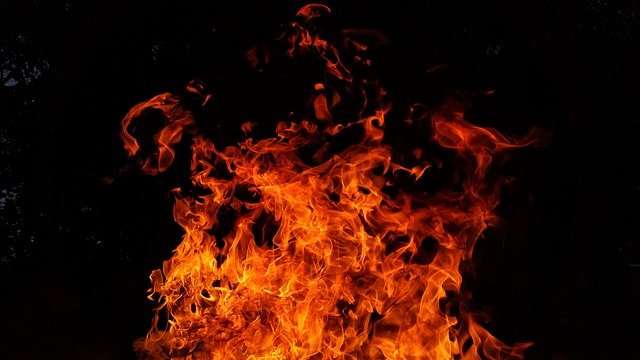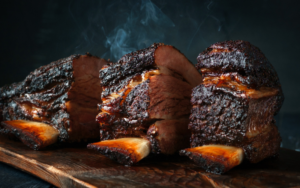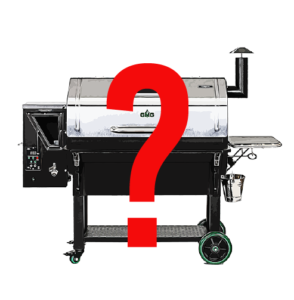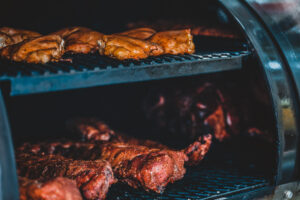I would be doing you a disservice if I didn’t talk about some of the negatives associated with pellet grills. Now, I love pellet grills and think they are perfect pieces of engineering that should be owned and enjoyed by all. I will 10/10 recommend this grilling system over any other. But…they aren’t perfect. Nothing is, and I want to share with you five common drawbacks.
No. 1 – the plug
Coming in at number one is…electricity. Yes, that’s right, it’s so simple but could pose an issue. My pellet grill sits under an open-air cabana, and a few summers ago we had electricity run from the house out to the structure. Pellet grills need to be plugged in because they rely on electricity to power the control board, which powers the induction fan, and tells the igniter when to glow red hot…basic operation of the pellet grill.
The drawback is not everyone has electricity, more specifically, a receptacle close by to plug the smoker in. I didn’t mention my grill being tucked under a cabana to boast either. I mentioned it because, before, I needed a 25 foot extension cord that ran from inside the house to the cabana to power my pellet grill. It was a bit inconvenient and looked a little on the trashy side when you have extension cords running everywhere. It’s definitely something to consider when looking out for a pellet grill.
No. 2 – wet pellets
The second drawback to pellet grills is pellet jams. I suppose you could call this a blockage as well, but we are describing the situation when pellets fail to make it to the firebox. There is nothing worse than being 8 hours into a smoke, and your grill loses temperature. What happened? Well, most likely a jam occurred either at the entry point of the pellets to the auger, somewhere in the middle of the auger tube, or at the point where pellets enter the firebox.
What causes the jam? Great question. It could be as simple as a cluster of pellets getting positioned just right and wedging themselves perfectly to cause a jam (not common because the pellets would normally break apart against the metal auger). The better answer is that this normally happens when moisture has entered the picture. After one to three smokes it’s best practice to clean out the hopper.
Wood pellets left in the hopper have the potential to attract moisture, and when this happens the pellets begin to swell. Several wood pellets with moisture combined with perfectly good pellets make their way to the auger, then auger tube, and wedge themselves creating a jam. This is also why it’s not the best idea to add new wood pellets to stale pellets left in the hopper.
I can’t stress this enough either. The quality of your hardwood pellets matter. Each pellet is sized specifically for the smoking application, and lignin in the wood holds the pellet shape. Low quality pellets break apart very easily and create wood dust (likely because of poor manufacturing processes). This dust can also combine with your pellets and create a jam. It’s best to spend a few extra dollars and get name brand pellets. I’ve learned the hard way…a few times.
No. 3 – fire
Pellet grills are very versatile machines that can smoke, barbecue, bake, broil, braise, roast, and sear. Because of that, they have a wide temperature range that they operate within. Regardless of the temperature you set your smoker at, you may experience something called a flare up. This is caused by the over filling of pellets into the firebox from the auger. When this occurs the over abundance of pellets catches fire, and as the fire spreads it’s possible to have a fire and have flames shoot out uncontrollably. The combination of too much ash, a faulty piece of electronics within the grill, or too much grease build up can all contribute to a flare up.
Flare ups are rare with pellet grills in the presence of regular maintenance. All that means is, fresh dry hardwood pellets are being used, ash is regularly cleaned out, and grease is routinely managed by either emptying the grease bucket or ensuring there are no obstructions to the flow of grease. What can you do if you experience a flare up? What you do is unplug the pellet grill, close the lid if not already closed, and allow the fire to go out naturally. This is assuming the grill is not fully engulfed. Please, always use judgment and common sense when dealing with a flare up. Don’t be a hero is what I’m really getting at, if you need a hose well then so be it, just unplug it first!
No. 4 – it’s smokin’
This is honestly a continuation of the above drawback. With flare ups, there can be a situation called back burn. Flare ups aren’t always the result of running the pellet grill at high heat, but that can happen. This happens more often with a high heat run, the pellets reach their smoke point in the middle of the auger tube or in the pellet hopper and begin to smolder or smoke. This phenomenon is called back burn and is caused by pellets beginning to smoke because of the high heat they are subjected to.
I’ve only had this happen to me one time, and it was when I had my pellet grill set at 500 degrees. I was reverse searing some steaks, and as I was waiting for the smoker to get to temperature it started billowing smoke out of the pellet hopper and letting off loud burps. Yeah, I know it was weird. The only thing I could figure was that I was probably experiencing back burn and a flare up causing pressure to look for escape which caused small burst of air, lifting my lid.
To stop a back burn you have to unfortunately stop the cook, clean out the hopper, clear the auger, and start over. However, as with number 3, this is not common in the presence of regular maintenance. Please perform the simple things so you can enjoy your pellet grill that much more.
No. 5 – show me the money
Up to this point I have talked about draw backs from an electronic or mechanical standpoint. The final drawback and listed at number 5 is cost. Like with any grilling system, whether it be charcoal, propane, or electric, there are tiers of models within each manufacturer. The same holds true across pellet grill brands.
Portable pellet grills are the cheapest, but they are also the smallest. They are great for portability and great tasting barbecue on the go, but they won’t regularly serve a moderate to large family. Then, you start getting bigger. Pellet grills are sized by surface area, so the bigger the surface area, generally the higher the price tag. A 600 square inch (sq. in.) pellet grill will be significantly cheaper than one that is over 1,000 sq. in.
Or will it? It depends on the brand and some other factors. This is where it gets complicated to people new to the craft. Each brand likely has its flagship pellet grill. It will have all the features available packed in mid and large size pellet grill. You can expect Blutooth & WiFi, ash cleanout, large hopper, digital control boards, just to name a few. It will also look good, but prepare to spend over $1,000.
Are there good pellet grills under $1,000? Yes, absolutely, but I feel that you have to be careful. You have to be careful because as you start to price a great pellet grill under $1,000 not all top tier features may make the list. With prices for a great pellet grill coming in at $750 – $1,000, it may be too much of an investment for some. However, many brands have stepped up and offer more affordable options while still retaining the pellet grill ethos.
Parting thoughts
Despite the drawbacks of pellet grills, they are largely avoidable with proper care and attention. They truly are easy to maintain, and offer more consistent, precise results than other grilling systems. Regarding cost, its important to make an informed decision and understand the nuances of different models of pellet grills across the various brands. It is an investment, but with a little knowledge and a curated purchase that investment will pay dividends.
Best,
David



